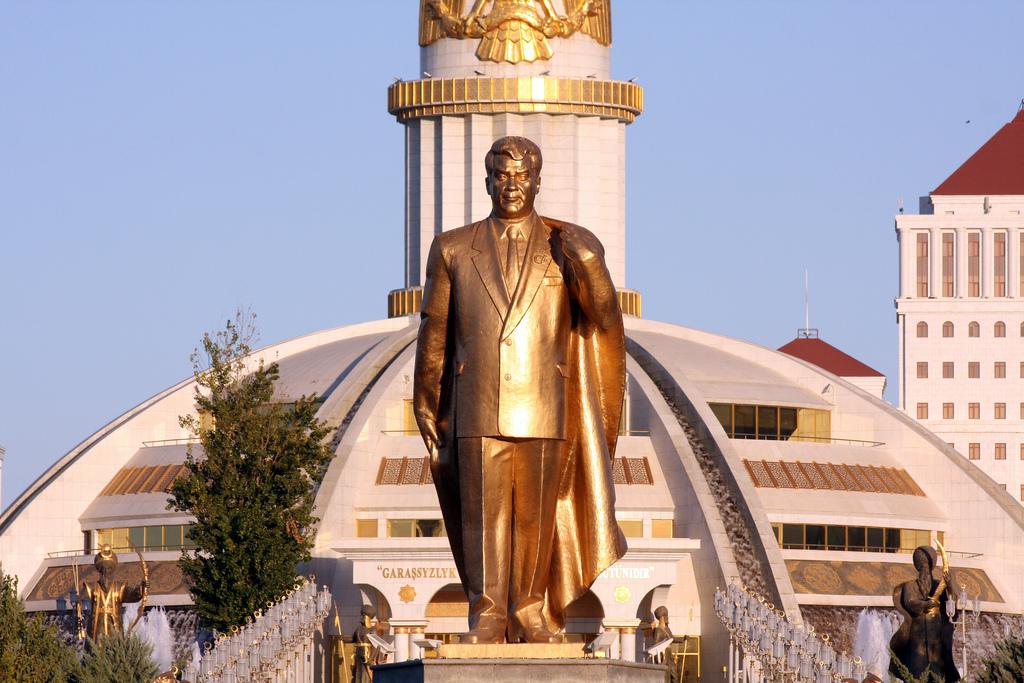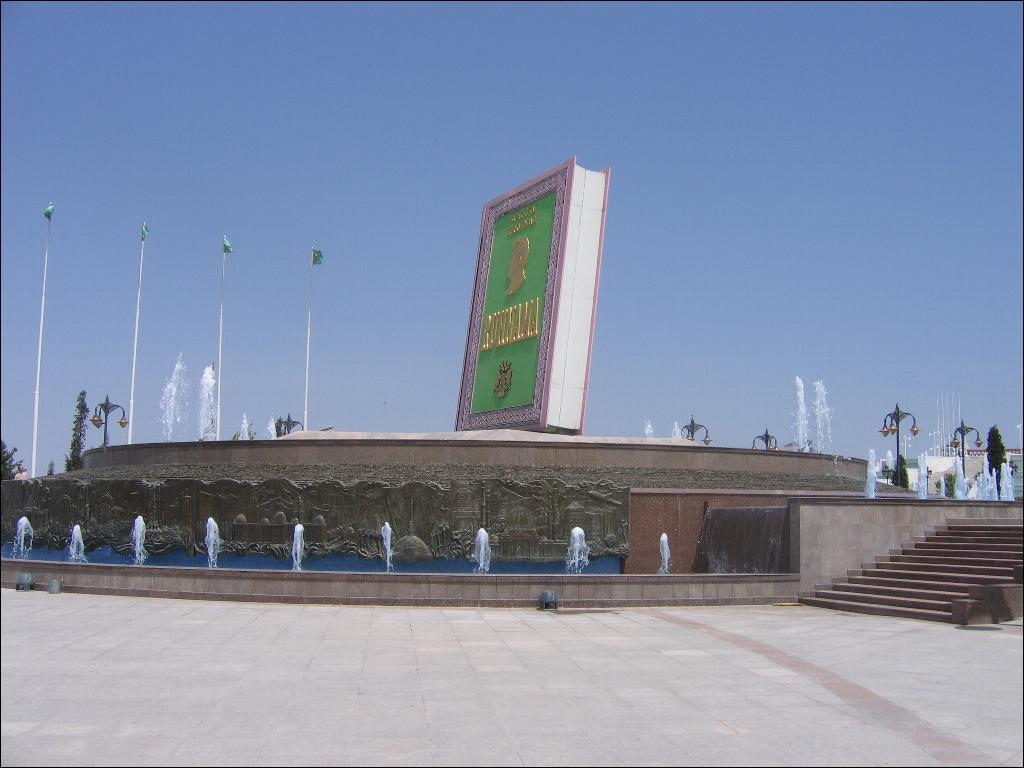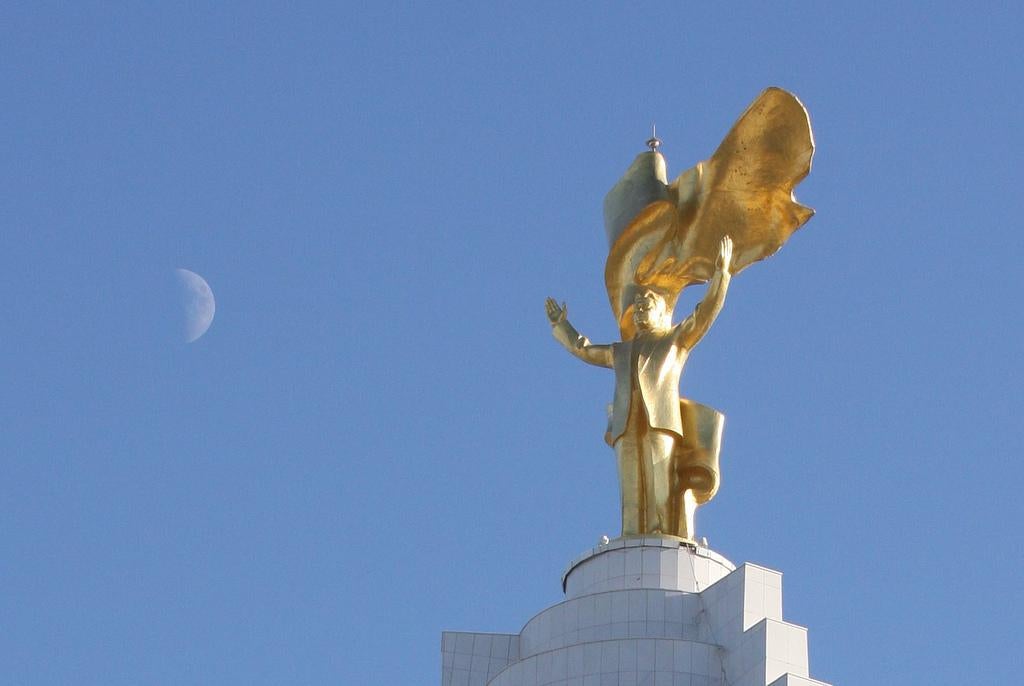Atlas Obscura on Slate is a blog about the world’s hidden wonders. Like us on Facebook, Tumblr, or follow us on Twitter @atlasobscura.
In a plaza on the southern outskirts of Turkmenistan’s capital, Ashgabat, sits a rocket-shaped monument called the Arch of Neutrality. Towering 312 feet above the ground, it is topped with a 40-foot golden man in a suit who stands with his arms outstretched, surveying the land as a flag ripples behind him. His body language and facial expression convey something along the lines of, “Bring it on. I’ve got this.”
The golden man is Saparmurat Niyazov, the quirk-riddled, megalomaniacal dictator who ruled Turkmenistan until his sudden death from heart failure in 2006. This Arch of Neutrality is a modified version of the one that used to sit in the city center. The original was topped with a statue of Niyazov that rotated so that it constantly faced the sun. In the modified monument, the former president is still.
Raised in a Soviet orphanage after his family died in an earthquake when he was eight, Saparmurat Niyazov joined the communist party in his early 20s and quickly rose through the political ranks of Turkmenistan. When the Soviet Union collapsed, Niyazov became president and took on the task of strengthening Turkmenistan’s independence and national character.
During his 16-year presidency, Niyazov — who named himself Turkmenbashi, or “Great Leader of All Turkmen” — enacted policies ranging from the enchantingly bizarre to the horrendously repressive. As with North Korean personality-cult hall-of-famers Kim Jong-il and Kim Il-sung, many decrees were based on Niyazov’s changeable whims. After heart surgery in 1997 forced him to quit smoking, Turkmenbashi forbade smoking in all public places. His irritation with beards, lip syncing, and gold teeth led to all three being outlawed. (Those who already had gold teeth had to get them extracted.) Niyazov also disliked makeup on TV presenters and, in 2004, mandated that newsreaders had to appear on screen with cosmetic-free faces “the color of wheat.”
In addition to outlawing things that annoyed him and plastering his portrait across the nation, Niyazov liked to name things after himself and his late mother. The city of Krasnovodsk and the month of January both became “Turkmenbashi”, while the month of April and the word for bread were changed to his mother’s name, Gurbansoltan.
Then there was the Walk of Health. To encourage physical activity among the citizens of Ashgabat, Niyazov installed 28 miles of concrete paths and staircases in the parched, treeless Kopet Dag mountains. All government employees had to walk a 23-mile section of the path once per year. Noyazov was not shy about expressing his displeasure when their speed dipped below his preferred pace. He delivered these chastisements at the finish line, which he traveled to via helicopter.
The most comprehensive — but often incomprehensible — insight into Niyazov’s mind came in the form of the Ruhnama (The Book of the Soul), a spiritual and philosophical tome he published in 2004. The rambling, repetitive Ruhnama combines revisionist Turkmen history, moral guidance, philosophical teachings, and Niyazov’s memoirs — with occasional side-trips to Turkmenbashi’s poetry.
Niyazov made study of the Ruhnama compulsory for all school children, to the exclusion of less-important subjects like physics or algebra. Adults were also required to study up — driving tests and job interviews incorporated material from the book. According to Niyazov, familiarity the Ruhnama would confer the ultimate benefit: he stated he had made a deal with God to ensure that anyone who read it three times would get a pass to heaven.
The 2006 death of Niyazov may have dimmed the golden glow of his personality cult, but relics of him live on in the form of strange laws, changed nomenclature, and those ostentatious gold-and-marble monuments. Meanwhile, Niyazov’s successor — and former dentist — Gurbanguly Berdimuhamedow is developing a bizarre personality cult of his own.
Berdimuhamedow’s fixation is Akhal-Teke horses, Turkmenistan’s national animal and emblem. The president’s equine predilections are something to behold — his book, The Flight of Celestial Race Horses, opens with the words: “I won’t call you horse, I would call you brother, you are dearer than brother.” In 2011, Berdimuhamedow decreed that the nation would host an annual beauty contest for horses.
Visit Atlas Obscura for more on Turkmenistan’s Niyazov legacy, including the Arch of Neutrality, the Giant Ruhnama, the Independence Monument, and the Walk of Health.

The Arch of Neutrality as it stands today (left) and in its original location (right).
Photos: Chris Price and Stefan Krasowski/Creative Commons

The Independence Monument, a.k.a. The Plunger.


A monument to the Ruhnama.
